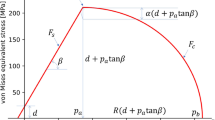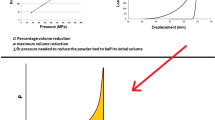Abstract
The aim of the current work was to model and understand the mechanical interactions of tooling heads with compression rollers during tableting. Binary direct compression blends of Prosolv® SMCC with 0.5% w/w magnesium stearate and ternary blends with 30% w/w acetaminophen were used. Tablet compression was performed using an instrumented Riva Piccola press with 10 mm round flat face D- and B-type TSM domed punches. Five punches were used for the study with varying dimensions of head flats. Strain rate studies were carried out at 12.5, 25, 50, and 75 revolutions of turret per minute (RPM) and a compaction profile was performed at compression pressures of 50, 100, 150, and 200 MPa. Tablet weight, thickness, and tensile strength were evaluated. Compression raw data was used to model the punch interactions. A MATLAB program was created to model the head profiles based on their dimensions, punch tip separation, vertical velocity, and pitch circle diameter of the press. Tablets compressed with no head flats were the weakest and showed less strain rate sensitivity. Tensile strengths increased linearly with the head flat dimensions. Also, difference in loading times due to roll movement during compression was evaluated. Capping was observed in tablets compressed at 75 RPM from the ternary blend containing 30% acetaminophen. However, punches with zero head flat showed no capping at these speeds. Also, B-type tooling showed relatively less capping tendency. This work shows that dwell time effect on tablet properties is based on the punch head flat region and the punch head interactions with the rollers.














Similar content being viewed by others
References
Dugar RP, Dave RH. To study the effects of solvent and relative humidity on rheological and thermal properties of microcrystalline cellulose granules using hydroxypropyl methylcellulose as binder. Int J Pharm Sci Res. 2014;5(9):3616.
Dugar RP, Gupta P, Dave RH. Effect of relative humidity on acetaminophen tablet properties prepared by different techniques using polyvinylpyrrolidine derivatives as binder. Int J Pharm Sci Res. 2015;6(11):4629.
Liebermann HA, Lachman L, Schwartz JB. Pharmaceutical dosage forms: tablets, vol. 2. New York: Marcel Dekker; 1990. p. 66–345.
Tank D, Karan K, Gajera BY, Dave RH. Investigate the effect of solvents on wet granulation of microcrystalline cellulose using hydroxypropyl methylcellulose as a binder and evaluation of rheological and thermal characteristics of granules. Saudi Pharm J. 2018;26(4):593–602.
Hörter D, Dressman JB. Influence of physicochemical properties on dissolution of drugs in the gastrointestinal tract1PII of original article: S0169-409X(96)00487-5. The article was originally published in Advanced Drug Delivery Reviews 25 (1997) 3–14.1. Adv Drug Deliv Rev. 2001;46(1):75–87.
Anbalagan P, Sarkar S, Liew CV, Heng PWS. Influence of the punch head design on the physical quality of tablets produced in a rotary press. J Pharm Sci. 2017;106(1):356–65.
Augsburger LE, Hoag S (Eds.), Alderborn G, Gray V, Geoffroy J, Bubb G, Lewis N, Nasr M, Chan K. Pharmaceutical dosage forms—tablets, vol. 3. 3rd ed. Boca Raton: Informa Healthcare; 2008.
Dugar RP, Gajera BY, Dave RH. Fusion method for solubility and dissolution rate enhancement of ibuprofen using block copolymer poloxamer 407. AAPS PharmSciTech. 2016;17(6):1428–40.
Chaudhari SP, Dugar RP. Application of surfactants in solid dispersion technology for improving solubility of poorly water soluble drugs. J Drug Delivery Sci Technol. 2017;41:68–77.
Gajera BY, Dugar RP, Dave RH. Formulation development and optimization of ibuprofen poloxamer melt granules using hydrophilic excipients. Br J Pharm Res. 2016;13(6):1–19.
Shan-Yang L. Effect of excipients on tablet properties and dissolution behavior of theophylline-tableted microcapsules under different compression forces. J Pharm Sci. 1988;77(3):229–32.
Charlton B, Newton J. Theoretical estimation of punch velocities and displacements of single-punch and rotary tablet machines. J Pharm Pharmacol. 1984;36(10):645–51.
Paul S, Sun CC. Gaining insight into tablet capping tendency from compaction simulation. Int J Pharm. 2017;524(1):111–20.
Singh A, de Bisschop C, Schut H, van Humbeeck J, van den Mooter G. Compression effects on the phase behaviour of miconazole-poly (1-vinylpyrrolidone-co-vinyl acetate) solid dispersions—role of pressure, dwell time, and preparation method. J Pharm Sci. 2015;104(10):3366–76.
Peeters E, Silva AFT, Fonteyne M, de Beer T, Vervaet C, Remon JP. Influence of extended dwell time during pre- and main compression on the properties of ibuprofen tablets. Eur J Pharm Biopharm. 2018;128:300–15.
Akande OF, Ford JL, Rowe PH, Rubinstein MH. Pharmaceutics: the effects of lag-time and dwell-time on the compaction properties of 1:1 paracetamol/microcrystalline cellulose tablets prepared by pre-compression and main compression. J Pharm Pharmacol. 1998;50(1):19–28.
Yu LX. Pharmaceutical quality by design: product and process development, understanding, and control. Pharm Res. 2008;25(4):781–91.
Kushner J, Moore F. Scale-up model describing the impact of lubrication on tablet tensile strength. Int J Pharm. 2010;399(1):19–30.
Baroutaji A, Lenihan S, Bryan K. Combination of finite element method and Drucker-Prager Cap material model for simulation of pharmaceutical tableting process. Mater Werkst. 2017;48(11):1133–45.
Kim TC, Changquan S, Amidon GE. Evaluation of the effects of tableting speed on the relationships between compaction pressure, tablet tensile strength, and tablet solid fraction. J Pharm Sci. 2005;94(3):465–72.
Swaminathan S, Ramey B, Hilden J, Wassgren C. Characterizing the powder punch-face adhesive interaction during the unloading phase of powder compaction. Powder Technol. 2017;315:410–21.
Yohannes B, Gonzalez M, Abebe A, Sprockel O, Nikfar F, Kiang S, et al. Evolution of the microstructure during the process of consolidation and bonding in soft granular solids. Int J Pharm. 2016;503(1):68–77.
Yohannes B, Gonzalez M, Abebe A, Sprockel O, Nikfar F, Kiang S, et al. Discrete particle modeling and micromechanical characterization of bilayer tablet compaction. Int J Pharm. 2017;529(1):597–607.
Anbalagan P, Liew CV, Heng PWS. Role of dwell on compact deformation during tableting: an overview. J Pharm Investig. 2017;47(3):173–81.
Roberts R, Rowe R. The effect of punch velocity on the compaction of a variety of materials. J Pharm Pharmacol. 1985;37(6):377–84.
Dudhat SM, Kettler CN, Dave RH. To study capping or lamination tendency of tablets through evaluation of powder rheological properties and tablet mechanical properties of directly compressible blends. AAPS PharmSciTech. 2017;18(4):1177–89.
Shah HG, et al. Influence of punch geometry (head-flat diameter) and tooling type (‘B’ or ‘D’) on the physical–mechanical properties of formulation tablets. Drug Dev Ind Pharm. 2018. https://doi.org/10.1080/03639045.2018.1525395.
Acknowledgements
The authors are thankful to Division of Pharmaceutical Sciences, Long Island University, and Natoli Institute of Industrial Pharmacy Research and Development at Long Island University to provide an opportunity to conduct the above research.
Author information
Authors and Affiliations
Corresponding author
Ethics declarations
Conflict of Interest
The authors declare that they have no conflict of interest.
Additional information
Publisher’s Note
Springer Nature remains neutral with regard to jurisdictional claims in published maps and institutional affiliations.
Rights and permissions
About this article
Cite this article
Dugar, R.P., Sedlock, R., Offenburger, C. et al. A Mechanistic Approach To Model the Compression Cycle of Different Toolings Based on Compression Roller Interactions. AAPS PharmSciTech 20, 21 (2019). https://doi.org/10.1208/s12249-018-1210-1
Received:
Accepted:
Published:
DOI: https://doi.org/10.1208/s12249-018-1210-1




